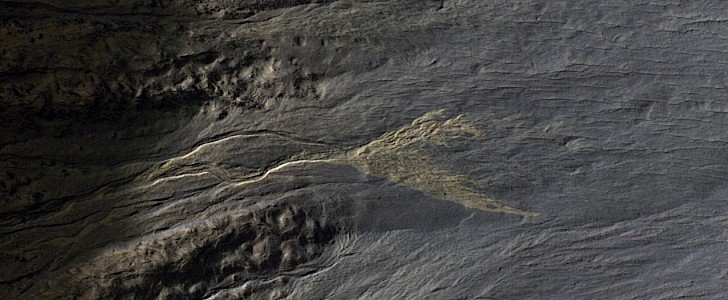Take a quick, undocumented look at the main image of this piece, and somewhere in the bright yellow middle your brain will compose the shape of some kind of alien hound with fat front legs, jumping over some invisible crevasse, or that of a winged beast sweeping down on its prey, or of a fish swimming in opposite direction from the other two. Something not unlike of an alien equivalent of a cave painting, if you will.
Brains do this on account of a phenomenon called pareidolia, which is more or less the tendency of the human mind to find meaningful shapes and patterns where there are really none. Couple that with the knowledge that the image being viewed is of an alien place, and science cannot fully explain it yet, and you’ve got the perfect recipe for a tumultuous trip in imagination land.
Before our eyes sits an image of Mars captured by the HiRISE camera from an altitude of 251 km (156 miles), back in 2009. We’re not being told exactly what region of the planet this is, but we do know we’re looking at gullies in a "small unnamed crater.”
The curious bit about this image is the bright yellow deposit “at the end of a gully channel.” It’s the one responsible for the pareidolia acting up again, but also a mystery for the people studying these images, who do not seem to know what it is made of.
What’s even more interesting is that the feature is relatively recent, and apparently came to be out of nowhere over the span of just two years – a previous photo of the region, snapped by HiRISE in 2007 (second pic in the gallery), does not seem to show it there.
Dead as far as life or volcanic activity are concerned, Mars is anything but when it comes to winds and quakes, so places that change appearance over time are not all that uncommon there. Some of them, however, like the one we have here, do seem particularly appealing to our eyes and minds.
Before our eyes sits an image of Mars captured by the HiRISE camera from an altitude of 251 km (156 miles), back in 2009. We’re not being told exactly what region of the planet this is, but we do know we’re looking at gullies in a "small unnamed crater.”
The curious bit about this image is the bright yellow deposit “at the end of a gully channel.” It’s the one responsible for the pareidolia acting up again, but also a mystery for the people studying these images, who do not seem to know what it is made of.
What’s even more interesting is that the feature is relatively recent, and apparently came to be out of nowhere over the span of just two years – a previous photo of the region, snapped by HiRISE in 2007 (second pic in the gallery), does not seem to show it there.
Dead as far as life or volcanic activity are concerned, Mars is anything but when it comes to winds and quakes, so places that change appearance over time are not all that uncommon there. Some of them, however, like the one we have here, do seem particularly appealing to our eyes and minds.









